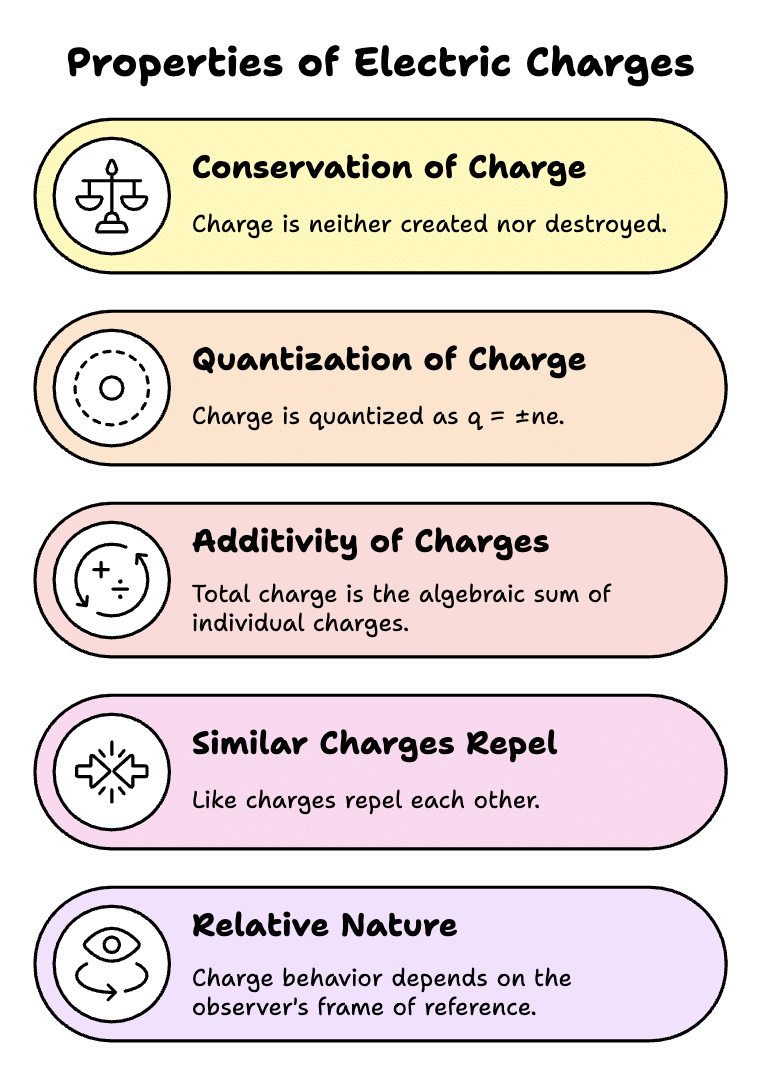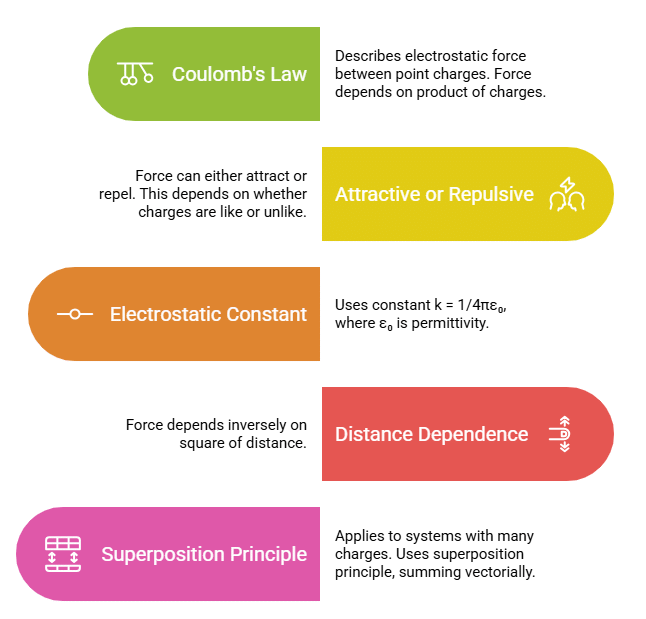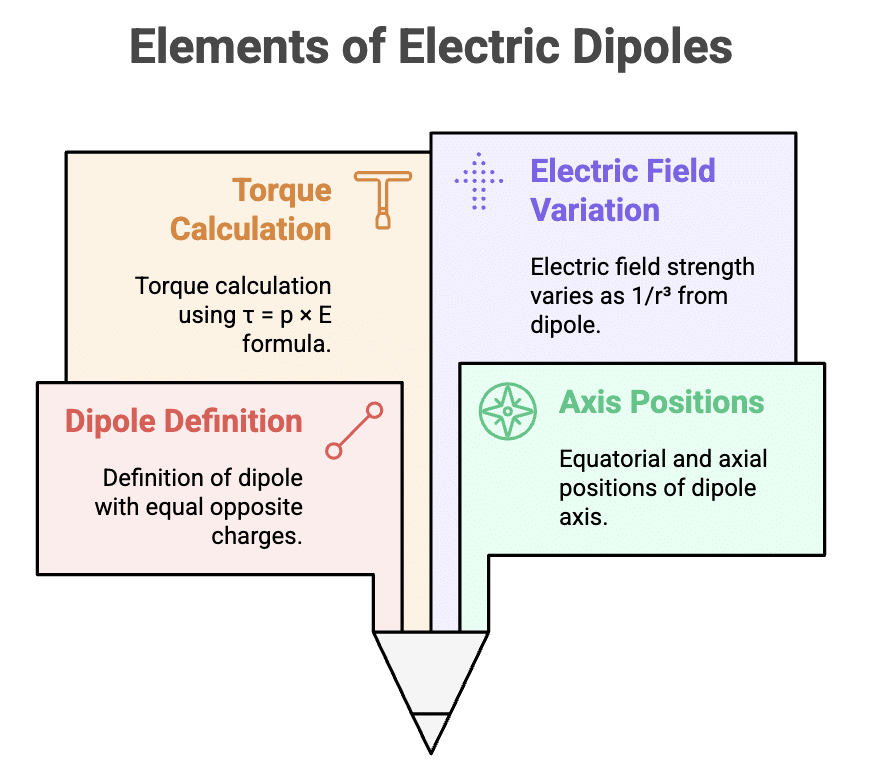Mnemonics: Electric Charges and Fields | Physics Class 12 - NEET PDF Download
| Table of contents |

|
| 1. Properties of Electric Charges |

|
| 2. Coulomb’s Law and Force |

|
| 3. Electric Field and Field Lines |

|
| 4. Electric Dipole Concepts |

|
| 5. Gauss’s Law and Applications |

|
1. Properties of Electric Charges
Mnemonic: "Cool Queens Add Spicy Rasam"
Cool – Conservation of Charge
Queens – Quantization of Charge
Add – Additivity of Charges
Spicy – Same Charges Repel
Rasam – Relative Nature
Electric charge follows several key properties essential for understanding electrostatics:
Conservation of charge means total charge remains constant in an isolated system.
Quantization tells us charge only exists in multiples of the elementary charge (e).
Additivity allows total charge to be calculated by algebraic sum.
Same charges repel while opposite charges attract—basic behavior of electric force.
Relative nature means observation of charge can depend on the motion or perspective of the observer

2. Coulomb’s Law and Force
Mnemonic: "Cool Friends Know Deep Science"
Cool – Coulomb’s Law (F = k·q₁·q₂ / r²)
Friends – Force is attractive or repulsive depending on charges
Know – k = 1/4πε₀ (electrostatic constant)
Deep – Depends inversely on square of distance
Science – Superposition Principle for multiple charges
Coulomb’s Law explains the electrostatic force between two point charges. The force:
Depends on the product of charges and inversely on the square of distance between them.
Can be attractive or repulsive, depending on whether the charges are unlike or like.
Uses the constant k = 1/4πε₀, where ε₀ is the permittivity of free space.
Applies to systems with many charges using the superposition principle, summing vectorially.

3. Electric Field and Field Lines
Mnemonic: "Every Field Shows Lovely Curves"
Every – Electric Field (E = F/q)
Field – Field due to point charges (E = kq/r²)
Shows – Superposition Principle for electric fields
Lovely – Lines start from positive and end at negative
Curves – Curved or straight lines depending on the configuration
The electric field (E) describes the force experienced by a test charge in a given field.
E = F/q shows the relationship between force and the test charge.
A point charge generates an electric field that is inversely proportional to the square of the distance: E = kq/r².
For multiple charges, the superposition principle applies, meaning the total field is the vector sum of all the individual fields.
Field lines:
Start from positive charges and end at negative charges.
Can be curved or straight, depending on how the charges are arranged in space.
4. Electric Dipole Concepts
Mnemonic: "Dipoles Always Torque Easily"
D – Dipole (two equal and opposite charges separated by a distance)
A – Axis (equatorial and axial positions)
T – Torque on dipole in an external field (τ = p × E)
E – Electric field due to dipole (varies as 1/r³)
An electric dipole consists of two charges of equal magnitude but opposite sign, separated by a distance.
The axis of the dipole refers to the line joining the two charges, and it has both equatorial (perpendicular to the axis) and axial (along the axis) positions.
The torque (τ) on a dipole in an external electric field is given by the formula τ = p × E, where p is the dipole moment and E is the electric field.
The electric field created by a dipole decreases with distance and follows the inverse cube law, i.e., it varies as 1/r³.
5. Gauss’s Law and Applications
Mnemonic: "Gauss Always Encloses Perfect Shapes"
- G – Gauss’s Law (Φ = q/ε₀)
- A – Applied to symmetric charge distributions
- E – Electric Flux through closed surface
- P – Permittivity of medium (ε₀ or ε)
- S – Surfaces: spherical, cylindrical, planar
Gauss’s Law (Φ = q/ε₀) relates the electric flux through a closed surface to the total charge enclosed within that surface.
Gauss’s law is applied to symmetric charge distributions, such as spherical, cylindrical, or planar symmetry, making it easier to calculate the electric field.
Electric flux (Φ) represents the number of electric field lines passing through a surface. It's integral to understanding how charges influence their surroundings.
Permittivity (ε₀) is a constant that describes how the electric field interacts with the medium. In vacuum, it's represented by ε₀, while in materials, it's ε.
The law applies to different surfaces: spherical, cylindrical, and planar. The geometry of the surface dictates the simplicity or complexity of the calculation.
|
74 videos|314 docs|88 tests
|
FAQs on Mnemonics: Electric Charges and Fields - Physics Class 12 - NEET
| 1. What are electric charges and how do they interact with each other? |  |
| 2. What is Coulomb's Law and how is it applied in electric fields? |  |
| 3. How do electric fields relate to electric charges? |  |
| 4. What are the characteristics of conductors and insulators in the context of electric charges? |  |
| 5. What role do electric fields play in the behavior of capacitors? |  |
















